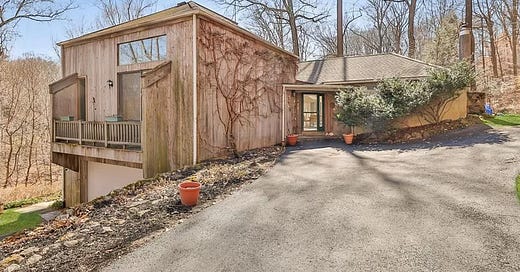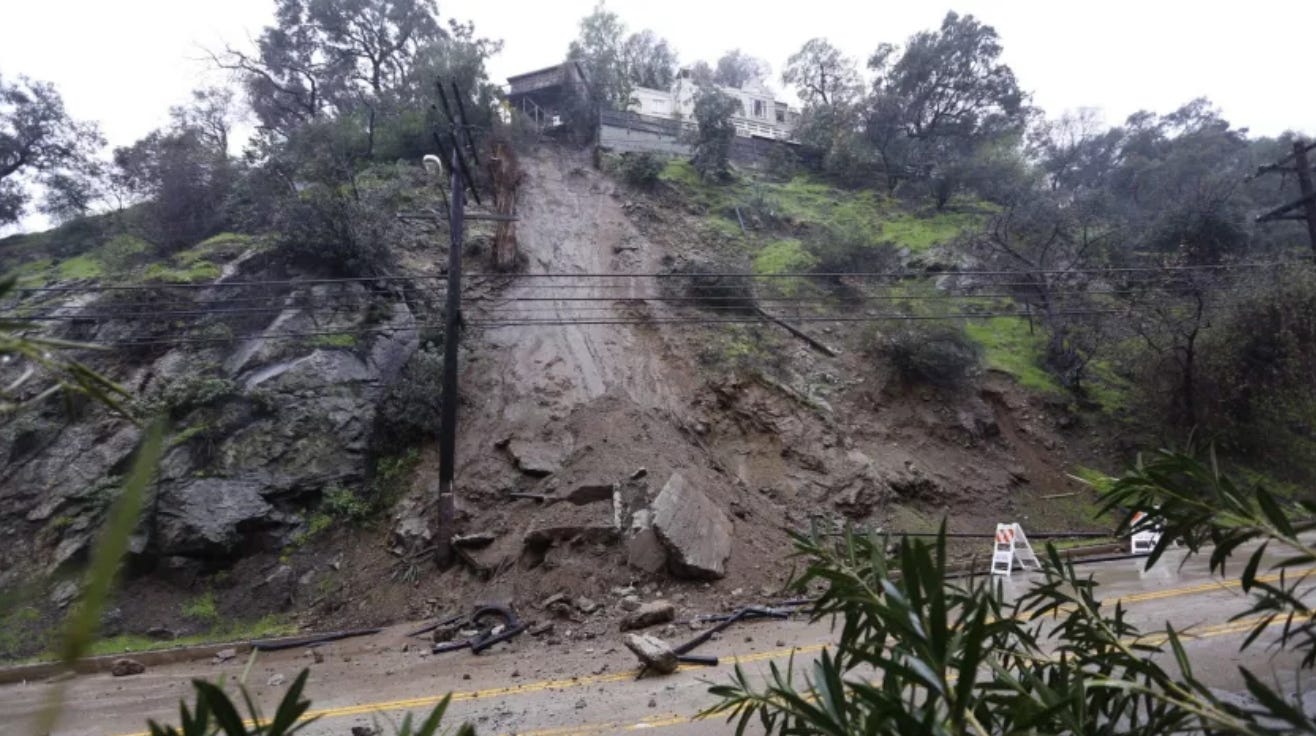The climate crisis is going to inflict significant changes on the world in the coming years as its direct impacts and second-order effects grow in magnitude. As market participants (people) begin to recognize this, assets that are rugged against climate change will grow in value, while those that are vulnerable to climate impacts will decline. This coming climate repricing is straightforward, but its implications are massive and not widely understood.
As we’ve discussed before, one implication is you should avoid buying or owning a home in a brittleness bubble area, or one that already has water issues.
Because the climate crisis will make the future significantly different from the past, we also want to avoid owning things that seem fine now but may not be in the coming years. As rainstorms get heavier and more intense, the segment of homes that are just barely holding off water issues will join the woeful group that already have them. You want to avoid these homes, but it can be hard to identify them.
I’ve been thinking about this a lot because my family and I are currently looking for a house. For example, we looked at this place recently:
[Zillow image of an attractive house deleted for privacy reasons]
We liked it – it was bright and warm inside and had a small but nice and grassy backyard. As I was looking around the exterior, I noticed a drain at the far end of the lawn. I registered it but didn’t give it much thought. On the drive home, talking through potentially making an offer on the house, we realized we’d forgotten to check its score on Flood Factor. When we did we got this:
[Image of 9/10 “EXTREME” Flood Factor score deleted for privacy reasons]
Not great! When I put my hand on the basement walls they hadn’t been damp at all, and there was no sign of a sump pump. But a 9/10 Flood Factor score is too high, so once we saw it we were out.
We kept poking around, though, and noticed that on Google Maps street view there’s a long puddle directly in front of the house, on the other side of the street.1 Another bad sign.
[Google Street View image of a puddle across from the house deleted for privacy reasons]
At this point, I put two and two together and realized the drain I’d seen in the lawn was probably a dry well put there to reduce wetness. It’s smart that the previous/current owners installed one, but, from the perspective of a potential buyer, it’s a bad sign that they needed to.
It’s hard to predict exactly what heavier rains in the future will mean for this house, but we know a few things:
Water risks (basement flooding, mold, etc.) are higher today than they were even just a few years ago.
Water risks will continue to increase into the future.
These increased water risks aren’t yet reflected in the prices of these homes.
Put it all together, and whoever buys this home is taking on climate repricing risk, which is the probability that a given house will be part of the future correction in asset values that occurs as the market comes to understand the magnitude, trajectory, and implications of climate change. Because today it’s not priced-in, the buyer will take on that risk without any corresponding benefit.
Needless to say, we didn’t make an offer on the house.
Flood Factor is a free service provided by First Street Foundation, a nonprofit whose mission is to:
Make climate risk accessible, easy to understand and actionable for individuals, governments, and industry.
Flood Factor pulls from a number of data sources and algorithmically weaves them together to produce a single number representing the future flood risk for a given location (they have data for most addresses in the U.S.). Here’s how First Street explains why they do what they do:
Institutional real estate investors and insurers have long had access to environmental risk data from for-profit oligopolies who use non-transparent methodologies that do not advance science and which limit access to risk information for the country. Because of this, the majority of Americans have relied on sources such as the Federal Emergency Management Agency (FEMA), the United States Forest Service, and other public agencies to understand their risk.
And those FEMA maps are not good. According to the New York Times:
Federal flood maps, managed by the Federal Emergency Management Agency, have long drawn concerns that they underestimate flood risk. Part of the problem is keeping the maps up to date, which is not only costly and labor intensive, but further complicated as climate change has worsened the dangers.
In addition, FEMA’s maps aren’t designed to account for flooding caused by intense rainfall, a growing problem as the atmosphere warms.
When FEMA does issue updated maps, politicians and homeowners often object, hoping to avoid higher federal flood insurance rates. “You can’t appeal your rate. You can only fight your map,” said Roy Wright, who ran the National Flood Insurance Program until 2018. “It turns it into house-by-house combat.”
As a home-buyer, Flood Factor is your friend. Use it.
A recent special report from the Tampa Bay Times on climate change and flooding risks included a story that’s stuck with me. It was about a couple, Victoria Glovitch and Chris Smith, whose recently-purchased first home flooded last year in Tropical Storm Eta. They endured incredible stress for months and barely avoided financial ruin. Glovitch started having panic attacks, which she’d never had before. She now wants to help people avoid what she and her husband went through.
She has started the process of securing a real estate license, hoping that anyone she helps will not have to experience the same nightmare. …She wishes that there were a better way to learn about past flooding on a property. When buyers ask, she said, it seems sellers and agents can always just answer: “Not to my knowledge.” The old owners of her home, she recalled, said they didn’t know about earlier floods.
Three comments on this:
I feel terrible for them and what they went through.
A surprisingly high proportion of what I’ve read about flooding emphasizes the incredible emotional toll that accompanies home flooding. It sounds awful.
Whether or not they know about a particular house’s history of flooding, most real estate agents are unlikely to warn clients against buying certain homes. At the very least, buyers shouldn’t count on it; the short-term incentives cut too strongly the other way. Similarly, home sellers are not going to warn you not to buy the house they’re trying to sell. As a home-buyer, you’re on your own.
Heavier rainstorms, and stronger hurricanes and tropical storms, will cause problems in the future, even for some houses and buildings that haven’t had them before. Caveat emptor.
The next house we seriously considered had a very safe 1/10 Flood Factor score. However, the lot seemed to hold a lot of water in certain places, which we didn’t love. In fairness, it had rained the day before we were there so some wetness was to be expected. Was this level of wetness more than what it should be if the soil were draining properly? Probably not to a degree that would be problematic, but hard to know for sure.
The house was also built into a hillside. How much of a risk is that? It depends.
From an LA Times article called “Spotting the slippery slope: What to watch out for when buying a hillside home”:
“Rain is the biggest cause of problems for hillside homes,” said Dave Grover of Grover Geology, who has examined at-risk properties since 1972. “Wet and dry cycles lead to heaving, shrinking of the soil and related building movement.”
The article concludes on this relatively upbeat note:
The good news is that most of the time, issues with hillside homes can be addressed.
“Usually we find homes need drainage and minor hillside work,” Grover said, noting that that kind of minor corrective work costs about $5,000 to $15,000.
“If you get into foundation repairs [or] slope stabilization work, though, that can cost many tens of thousands of dollars, but that’s not as common,” he continued. “Most of the time, it’s small problems that can be solved.”
It’s important to know – especially for those who already own homes that might be vulnerable to more intense rainstorms – that there are physical changes you can make to mitigate water-related risks. But as a prospective buyer, I don’t find it terribly comforting that “most of the time” a house I might buy can be made safe. At these sky-high housing prices, I’d like something that’s more of a sure thing.
A broader concern is that standard advice is often based, implicitly, on the assumption that weather in the future will look like weather in the past. But we know, and have seen over and over, that assumption will not hold in the age of climate change. As I wrote in January in The climate crisis means destabilization, not doom:
For more than 37 years, from July 1967 through August 2004, the most rain that ever fell in a single hour in New York City’s Central Park was 1.58 inches. Then in September 2004, 1.76 inches fell in an hour. This record stood until August 21, 2021, when 1.94 inches of rain came down in sixty minutes. The two previous New York City records for rainfall in an hour had lasted for 37 and 17 years, respectively, but this one would last just 11 days. On September 1, 2021, over the course of one hour, Hurricane Ida dropped 3.15 inches of rain on the city. A record broken twice by 0.18 inches was obliterated by 1.21 inches. The deluge caused widespread flooding, in which eighteen New Yorkers died.
There are countless examples like this. In the past decade, Texas had several 500-year rainfalls and flooding in just five years. A month ago, Brisbane, Australia received 80 percent of a normal year’s worth of rainfall in 3 days – more rain than falls in London in a year. There are scores of examples all over the world.
So about that house on the side of the hill. Should we make an offer?
We ultimately did make an offer on the hillside house. We planned to have an engineer do the inspection, and look closely at the foundation and elsewhere for any signs of shifting earth. We were considering having a geologist do an analysis of the soil and its potential vulnerability in heavy rain.
We ended up being out-bid on the house so it was moot. My disappointment when I found out was mixed with relief. It was partly about not having to wonder in heavy rains whether the weight of the house plus the water would make the gravitational force acting on the soil greater than the frictional forces holding it in place, causing the hillside ground under and around the house to begin to give way.
That probably wouldn’t happen to this house on this hillside – I’d bet against it – but I’m happy for someone else to take the risk.
Notes
https://www.nytimes.com/interactive/2020/06/29/climate/hidden-flood-risk-maps.html
https://projects.tampabay.com/projects/2022/hurricane/rising-threat/climate-change-flood-maps/
https://www.latimes.com/business/realestate/hot-property/la-fi-hp-rain-hillside-homes-20170408-story.html
https://www.bbc.com/news/world-australia-60686223
https://www.texasobserver.org/tropical-storm-imelda-will-likely-be-southeast-texas-fifth-500-year-flood-in-five-years/
https://en.wikipedia.org/wiki/List_of_floods#Floods_by_region
Of course it may have rained 20 minutes before the Google camera car drove by – it looks like it did. But that much standing water is not great in any case.






